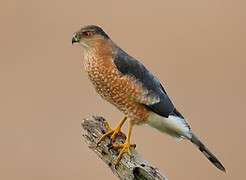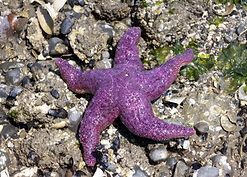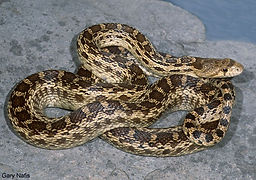
Mammals
Mammals are typically found on land, where they resided in the trees, on the ground, or underground. While these are the most obvious places we can find them, some mammals live in the water as well. The hair on mammals plays several important roles in keeping them safe. Not only does hair help keep these warm-blooded creatures warm, but it also allows for many of them to camouflage with their surroundings. Take a look at the different patterns, stripes, and spots on the creatures below to see how well these animals blend in to their habitat. Mammals distinguish themselves from other animals by their incredible brains, which is the most complex organ we know to exist. These brains help mammals to learn and adapt. Additionally, female mammals are the only animals capable of producing milk in order to care for their young. As humans, in Orange County, we often exist alongside other mammals and so we must be conscientious of how we interact with the earth so that we do not accidentally destroy their habitats and endanger their lives.

Lynx rufus
Otospermophilus beecheyi
Puma Concolor
Procyon lotor
Canis latrans
Odocoileus hemionus
Cougar
Puma concolor
Eastern Fox Squirrel
Sciurus niger
Southern Sea Otter
Enhydra lutris
Ringtail
Bassariscus astutus
Broad-footed Mole
Scapanus latimanus
Virginia Opossum
Didelphis virginiana
Gray Fox
Urocyon cinereoargenteus
Striped Skunk
Mephitis mephitis
California Sea Lion
Zalophus californianus
Pallid Bat
Antrozous pallidus
Ornate Shrew
Sorex ornatus
Dusky-footed Woodrat
Neotoma fuscipes
Western Gray Squirrel
Sciurus griseus
Long-Tailed Weasel
Mustela frenata
Harbor Seal
Phoca vitulina
Big Brown Bat
Eptesicus fuscus
Desert Cottontail
Sylvilagus audubonii
Pacific Pocket Mouse
Perognathus longimembris pacificus
Botta's Pocket Gopher
Thomomys bottae
Birds
Birds are specially adapted for flight, characteristic of their feathers, beaks, and pair of wings.
A bird’s skeletal and muscle structures allow them to fly, with hollow and lightweight bones supported by strong chest muscles. Their wings, which are curved from the front to the back, allow air to push the bird up as it flaps its wings. Some birds are even able to glide, soar, or hover in place using special adaptations. The feathers that cover the bodies of all avian species serve multiple functions, from providing lift and allowing flight, attracting mates, and protecting against water or other contaminants. Like mammals, birds are warm-blooded and will use their feathers in keeping warm. The beaks of each bird species are unique, depending on their diet and lifestyles. They are also known to lay their eggs in nests found high above the ground away from predators, but some are known to burrow underground or on the surface.

Charadrius nivosus
Passerculus sandwichensis
Eared Grebe
Podiceps nigricollis
Common Poorwill
Phalaenoptilus nuttallii
Brown Pelican
Pelecanus occidentalis
Double Crested Cormorant
Phalacrocorax auritus
Snowy Egret
Egretta thula
Brant Goose
Branta bernicla
Allen's Hummingbird
Selasphorus sasin
House Wren
Troglodytes aedon
Polioptila californica
Rallus obsoletus
Ruddy Duck
Oxyura jamaicensis
Surf Scooter
Melanitta perspicillata
American Coot
Fulica americana
Western Gull
Larus occidentalis
Sanderling
Calidris alba
Greater Roadrunner
Geococcyx californianus
American Goldfinch
Spinus tristis
Northern Mockingbird
Mimus polyglottos
Sterna antillarum browni
Lophortyx californica
Nuttall's Woodpecker
Picoides nuttallii
Western Scrub Jay
Aphelocoma californica
Song Sparrow
Melospiza melodia
Say's Phoebe
Sayornis saya
Yellow-Rumped Warbler
Setophaga coronata
Tree Swallow
Tachycineta bicolor
Bullock's Oriole
Icterus bullockii
Rock Pigeon
Petrophassa albipennis
Birds of Prey
Birds of prey are characterized by their carnivorous diet and the many adaptations that allow them to hunt other small mammals, birds, reptiles, or insects. They have strong hooked beaks that allow them to bite and tear into animal prey. They also have keen eyesight to be able to spot prey from afar, and powerful toes and talons to grasp them.

Buteo jamaicensis
Pandion haliaetus
Sharp-shinned Hawk
Accipiter striatus
Falco peregrinus
Falco sparverius
White-tailed Kite
Elanus leucurus
Northern Harrier
Circus cyaneus
Bubo virginianus
Accipiter cooperii
Red-shouldered Hawk
Buteo lineatus
Amphibians
These cold-blooded creatures can be found in water or moist environments. These living conditions are essential for their survival as excessive sun and wind exposure can be dangerous to them. Sun can hurt their cells and wind can cause their skin to become dry. These elements will effect their skin that has special features allowing it to breathe and take in water. Most amphibians goes through a metamorphosis of egg to larva to adult. The larva are also known as tadpoles. Eventually they will morph into having limbs and lungs and potentially lose their tails. Once they are adults, they find their way out of the water and can live on land. Keep an eye out for amphibians that are brightly colored as this is an indicator that they may be posionous!

Anaxyrus boreas
Taricha torosa
Aneides lugubris
Batrachoseps attenuatus
Pseudacris cadaverina
Pseudacris hypochondriaca
Bullfrog
Lithobates catesbeianus
Arroyo Toad
Anaxyrus californicus
Insects
The insects of Orange County come in a variety of colors, shapes, and sizes. Each insect in Orange County also lives in their preferred habitat and have evolved to their individual adaptations to survive, compete for resources, and reproduce. These organisms range from being our native pollinators to being invasive species that we commonly see during the warmer months in OC. Though they are small, they are extremely important to the stability of our ecosystem as they often help maintain healthy soil, recycle nutrients, pollinate flowers and crops, and control pests. Learn more about the insects of Orange County below!

Danaus plexippus
Bibio albipennis
Pipevine Swallowtail Butterfly
Battus philenor
Western Tiger Swallowtail Butterfly
Papilio rutulus
Checkered White Butterfly
Pontia protodice
Southern Dogface Butterfly
Zerene cesonia
Sara Orangetip Butterfly
Anthocharis sara
Striated Queen Butterfly
Danaus gilippus strigosus
California Ringlet
Coenonympha tullia
Cockroaches
Periplaneta americana
Aphid
Aphidoidea
Adelpha californica
Aedes aegypti
Great Basin Wood-Nymph
Cercyonis sthenele
Common Buckeye
Junonia coenia
Mourning Cloak
Nymphalis antiopa
Red Admiral
Vanessa atalanta
Great Purple Hairstreak
Atildes halesus
Western Pygmy - Blue
Brephidium exilis
Western Tailed - Blue
Cupido amyntula
Leaf Miner Fly
Calycomyza enceliae
Bed Bugs
Cimex lectularius
Ladybug
Coccinellidae
Euphydryas chalcedona
Latrodectus mactans
Gorgon Copper
Lycaena gorgon
Silverfish
Lepisma saccharinum
Bristletail
Ctenolepisma lineata
Creosote Gall Midge
Asphondylia auripila
Bathroom Moth Fly
Clogmia albipunctata
Dark-Winged Fungus Gnat
Eugnoriste sp.
Crane Fly
Limonia sp.
Cricket
Grylloidea
Human Flea
Pulex irritans
Marine
Marine animals in the intertidal zone are those that live where the ocean meets the land. These organisms exhibit a variety of adaptations which determine the depth of the water they reside in. The low intertidal zone is the deepest zone and it typically stays wet even when there is a low tide. The mid-intertidal zone is covered with water during most high tides and is exposed to the air during most low tides. The high intertidal zone is only covered in water during the highest tides, but is exposed to the air most of the time. Lastly, the splash zone is the highest and driest zone and receives its moisture from the ocean spray. Some organisms need more water while others are adapted to drier conditions. These factors, along with competition with other organisms for space, determine which zone an organism will be found.

Pachygrapsus crassipes
Octopus bimaculoides
Black Abalone
Haliotis cracherodii
Eccentric Sand Dollar
Dendraster excentricus
California Mussel
Mytilus californianus
Pisaster ochraceus
Anthopleura elegantissima
White Abalone
Haliotis sorenseni
California Sea Cucumber
Parastichopus californicus
Rough Limpet
Lottia scabra
Aplysia californica
Megastraea undosa
California Aglaja
Navanax inermis
Pacific Purple Sea Urchin
Strongylocentrotus purpuratus
Gooseneck Barnacle
Pollicipes polymerus
Freshwater
Freshwater animals consist of those which reside in or near our county’s lakes, rivers, streams, and freshwater marshes. These habitats include a variety of animals including fish, rodents, mammals, and birds. They typically consist of relatively shallow waters and are characterized by their low salt content. These areas provide a vital source of water for nearby organisms. Some animals here are adapted to use the water to their advantage by hiding in it to get away from predators while others use their unique coloring that provides camouflage from potential predators.

Lepomis macrochirus
Castor canadensis
Bobcat
Lynx rufus
Great Egret
Ardea alba
Copepod
Copepoda
Yellow Pike
Sander vitreus
Ameiurus melas
Esox masquinongy
Whooping Crane
Grus americana
Crayfish
Palinuridae
Smallmouth Bass
Micropterus dolomieu
White Crappie
Pomoxis annularis
Yellow Bullhead
Ameiurus natalis
Micropterus salmoides
Ondatra zibethicus
Downy Woodpecker
Dryobates pubescens
Great Blue Heron
Ardea herodias
Northern Pike
Esox lucius
Yellow Perch
Perca flavescens
Reptiles
These reptiles can be found in all habitats across Orange County, from the wetlands to the drier woodlands. Since these reptiles span across varies habitats, they have developed a number of different adaptations to survive. One of the key adaptations that allows reptiles to live on land is the development of scaly skin, which helps in reducing their water loss from the skin. They are cold-blooded creatures, which helps them most to adapt in warmer climates, especially summers in Southern California. Types of reptiles commonly found in Orange County are lizards, snakes, and turtles. Find out more information about them below!

Elgaria multicarinata
Phrynosoma blainvillii (coronata)
Red Racer
Coluber flagellum piceus
Rosy Boa
Lichanura trivirgata
Western Fence Lizard
Sceloporus occidentalis
California Legless Lizard
Anniella stebbinsi
Granite Spiny Lizard
Sceloporus orcutti
Pituophis catenifer catenifer
Actinemys pallida
Southwestern Threadsnake
Rena humilis humilis
Southern Pacific Rattlesnake
Crotalus oreganus helleri
Red Diamond Rattlesnake
Crotalus ruber
Coast Patch-nosed Snake
Salvadora hexalepis virgultea
Western Black-Headed Snake
Tantilla planiceps
Aspidoscelis hyperythra
Trachemys scripta elegans
Western Skink
Plestiodon skiltonianus
Two-striped Garter Snake
Thamnophis hammondii
Western Yellow-bellied Racer
Coluber constrictor mormon
Side Blotched Lizard
Uta stansburiana
Green Sea Turtle
Chelonia myda








_(6326191981).jpeg)








































